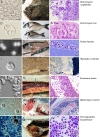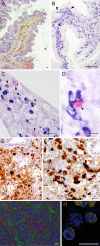To React or Not to React: The Dilemma of Fish Immune Systems Facing Myxozoan Infections
- PMID: 34603313
- PMCID: PMC8481699
- DOI: 10.3389/fimmu.2021.734238
To React or Not to React: The Dilemma of Fish Immune Systems Facing Myxozoan Infections
Abstract
Myxozoans are microscopic, metazoan, obligate parasites, belonging to the phylum Cnidaria. In contrast to the free-living lifestyle of most members of this taxon, myxozoans have complex life cycles alternating between vertebrate and invertebrate hosts. Vertebrate hosts are primarily fish, although they are also reported from amphibians, reptiles, trematodes, mollusks, birds and mammals. Invertebrate hosts include annelids and bryozoans. Most myxozoans are not overtly pathogenic to fish hosts, but some are responsible for severe economic losses in fisheries and aquaculture. In both scenarios, the interaction between the parasite and the host immune system is key to explain such different outcomes of this relationship. Innate immune responses contribute to the resistance of certain fish strains and species, and the absence or low levels of some innate and regulatory factors explain the high pathogenicity of some infections. In many cases, immune evasion explains the absence of a host response and allows the parasite to proliferate covertly during the first stages of the infection. In some infections, the lack of an appropriate regulatory response results in an excessive inflammatory response, causing immunopathological consequences that are worse than inflicted by the parasite itself. This review will update the available information about the immune responses against Myxozoa, with special focus on T and B lymphocyte and immunoglobulin responses, how these immune effectors are modulated by different biotic and abiotic factors, and on the mechanisms of immune evasion targeting specific immune effectors. The current and future design of control strategies for myxozoan diseases is based on understanding this myxozoan-fish interaction, and immune-based strategies such as improvement of innate and specific factors through diets and additives, host genetic selection, passive immunization and vaccination, are starting to be considered.
Keywords: B lymphocytes; RNAseq; T lymphocytes; adaptive immunity; immune evasion; immunoglobulin; parasite; teleost.
Copyright © 2021 Holzer, Piazzon, Barrett, Bartholomew and Sitjà-Bobadilla.
Conflict of interest statement
The authors declare that the research was conducted in the absence of any commercial or financial relationships that could be construed as a potential conflict of interest.
Figures




Similar articles
-
The kinetics of cellular and humoral immune responses of common carp to presporogonic development of the myxozoan Sphaerospora molnari.Parasit Vectors. 2019 May 6;12(1):208. doi: 10.1186/s13071-019-3462-3. Parasit Vectors. 2019. PMID: 31060624 Free PMC article.
-
Acquired Protective Immunity in Atlantic Salmon Salmo salar against the Myxozoan Kudoa thyrsites Involves Induction of MHIIβ+ CD83+ Antigen-Presenting Cells.Infect Immun. 2017 Dec 19;86(1):e00556-17. doi: 10.1128/IAI.00556-17. Print 2018 Jan. Infect Immun. 2017. PMID: 28993459 Free PMC article.
-
Fish immune response to Myxozoan parasites.Parasite. 2008 Sep;15(3):420-5. doi: 10.1051/parasite/2008153420. Parasite. 2008. PMID: 18814716 Review.
-
Biology and mucosal immunity to myxozoans.Dev Comp Immunol. 2014 Apr;43(2):243-56. doi: 10.1016/j.dci.2013.08.014. Epub 2013 Aug 29. Dev Comp Immunol. 2014. PMID: 23994774 Free PMC article. Review.
-
Repatriation of an old fish host as an opportunity for myxozoan parasite diversity: The example of the allis shad, Alosa alosa (Clupeidae), in the Rhine.Parasit Vectors. 2016 Sep 15;9(1):505. doi: 10.1186/s13071-016-1760-6. Parasit Vectors. 2016. PMID: 27628643 Free PMC article.
Cited by
-
Ceratonova shasta: a cnidarian parasite of annelids and salmonids.Parasitology. 2022 Dec;149(14):1862-1875. doi: 10.1017/S0031182022001275. Epub 2022 Sep 9. Parasitology. 2022. PMID: 36081219 Free PMC article. Review.
-
Responses to pathogen exposure in sentinel juvenile fall-run Chinook salmon in the Sacramento River, CA.Conserv Physiol. 2023 Aug 28;11(1):coad066. doi: 10.1093/conphys/coad066. eCollection 2023. Conserv Physiol. 2023. PMID: 37649642 Free PMC article.
-
A New Myxobolus (Cnidaria: Myxosporea: Myxobolidae) from the Gill Arch of the Western Creek Chubsucker, Erimyzon claviformis (Cypriniformes: Catostomidae), in Arkansas, USA.Acta Parasitol. 2025 Mar 10;70(2):68. doi: 10.1007/s11686-025-01001-6. Acta Parasitol. 2025. PMID: 40059240
-
Infection by the Parasite Myxobolus bejeranoi (Cnidaria: Myxozoa) Suppresses the Immune System of Hybrid Tilapia.Microorganisms. 2022 Sep 23;10(10):1893. doi: 10.3390/microorganisms10101893. Microorganisms. 2022. PMID: 36296170 Free PMC article.
-
Effects of Genetic Diversity on Health Status and Parasitological Traits in a Wild Fish Population Inhabiting a Coastal Lagoon.Animals (Basel). 2025 Jul 25;15(15):2195. doi: 10.3390/ani15152195. Animals (Basel). 2025. PMID: 40804984 Free PMC article.
References
-
- Okamura B, Gruhl A, Bartholomew JL. An Introduction to Myxozoan Evolution, Ecology and Development. In: Okamura B, Gruhl A, Bartholomew JL, editors. Myxozoan Evolution, Ecology and Development. Switzerland: Springer; (2015). p. 1–22. doi: 10.1007/978-3-319-14753-6 - DOI
-
- Álvarez-Pellitero P, Sitjà-Bobadilla A. Pathology of Myxosporea in Marine Fish Culture. Dis Aquat Organ (1993) 17:229–38. doi: 10.3354/dao017229 - DOI
-
- Moran JDW, Whitaker DJ, Kent ML. A Review of the Myxosporean Genus Kudoa Meglitsch, 1947, and its Impact on the International Aquaculture Industry and Commercial Fisheries. Aquaculture (1999) 172:163–96. doi: 10.1016/S0044-8486(98)00437-2 - DOI
Publication types
MeSH terms
Substances
LinkOut - more resources
Full Text Sources

